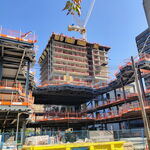nfitz
Superstar
That's interesting.It seems like they want to route the Ontario Line north to Sheppard, then Richmond Hill Centre, then head west to Pearson Airport
So Relief Line North option 4, but then cut west to Richmond Hill Centre. Though if they are doing that, why not do option 3, and eliminate the Richmond Hill GO line inside Toronto? Would be much cheaper.




